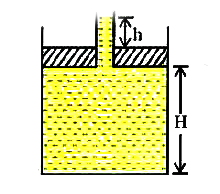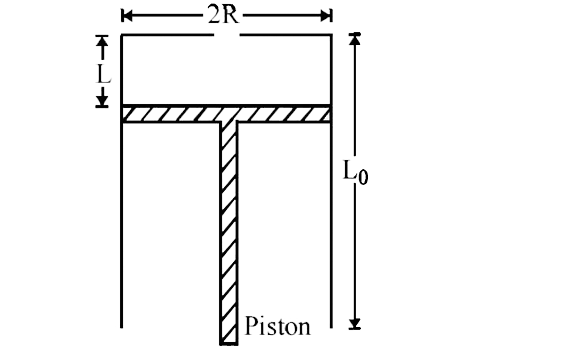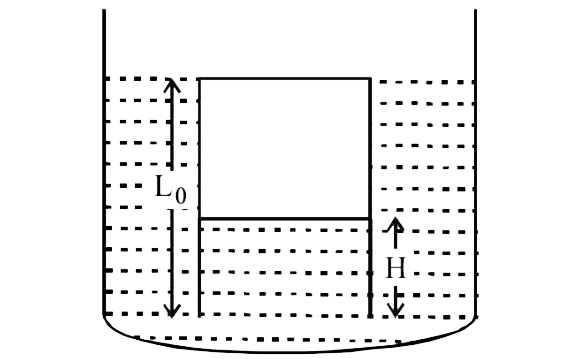A piston of mass m = 3kg and radius R = 4cm has a hole into which a thin pipe of radius =lem is inserted, the pistion can enter a cylinder tightly and without friction, and initially it is at the bottom of the cylinder, 750gm of water is now poured into the pipe so that the pistion &pipe are lifted up as shown. Find the height H of water in the cylinder and heighth of water in the pipe.

h=2mπ,H=1132πm
Topper's Solved these Questions
- FLUID MECHANICSBOOK - AAKASH SERIESCHAPTER - FLUID MECHANICSEXERCISE - Questions for Descriptive Answers
14 Videos
- FLUID MECHANICSBOOK - AAKASH SERIESCHAPTER - FLUID MECHANICSEXERCISE - Numerical Exercise (LEVEL-1)
19 Videos
- EXPANSION OF SOLIDS BOOK - AAKASH SERIESCHAPTER - EXPANSION OF SOLIDS EXERCISE - Questions for Descriptive Answers
5 Videos
- FRICTION BOOK - AAKASH SERIESCHAPTER - FRICTION EXERCISE - ADDITIONAL PRACTICE EXERCISE PRACTICE SHEET (ADVANCED) (MORE THAN ONE CORRECT ANSWER TYPE QUESTIONS)
1 Videos
Similar Questions
_E01_201_Q01.png)
A piston of mass M=3kg and radius R=4cm has a hole into which a thin pipe of radius r=1 cm is inserted the piston can enter a cylinder tightly and without friction an initially it is at the bottom of the cylinder 750 gm of water is now poured into the pipe so that the piston&pipe and lifted up as shown find the height H of water in the cylinder and height h of water in the pipe.
View Solution_E01_201_Q01.png)
A piston of mass M=3kg and radius R=4cm has a hole into which a thin pipe of radius r=1 cm is inserted the piston can enter a cylinder tightly and without friction an initially it is at the bottom of the cylinder 750 gm of water is now poured into the pipe so that the piston&pipe and lifted up as shown find the height H of water in the cylinder and height h of water in the pipe.
View Solution
Knowledge Check
Water is flowing in a pipe of diameter 4 cm with a velocity 3m/s . The water then enters into a tube of diameter 2 cm . The velocity of water in the other pipe is
A3m/sB6m/sC12m/sD8m/sA fixed thermally conducting cylinder has a radius R and height L0. The cylinder is open at ita bottom and has a small hole at its top. A piston of mass M is held at a distance L from the top surface, as shown in the figure. The atmospheric pressure is P0.

The piston is taken completely out of the cylinder. The hole at the top is sealed. A water tank is brought below the cylinder and put in a position so that the water surface in the tank is at the same level as the top of the cylinder as shown in the figure. The density of the water is ρ. In equilibrium, the height H of the water coulmn in the cylinder satisfies
 Aρg(L0−H)2+P0(L0−H)+L0P0=0Bρg(L0−H)2−P0(L0−H)−L0P0=0Cρg(L0−H)2+P0(L0−H)−L0P0=0Dρg(L0−H)2−P0(L0−H)+L0P0=0
Aρg(L0−H)2+P0(L0−H)+L0P0=0Bρg(L0−H)2−P0(L0−H)−L0P0=0Cρg(L0−H)2+P0(L0−H)−L0P0=0Dρg(L0−H)2−P0(L0−H)+L0P0=0A sufficiently long closed organ pipe has a small hole at its bottom . Initially , the pipe is empty . Water is poured into the pipe at a constant rate . The fundamental frequency of the air column in the pipe
Acontinuously increasesBfirst increases and then becomes constantCcontinuously decreasesDfirst decreases and then becomes constant
A conical vessel with radius 10 cm and height 15 cm is completely filled with water. This water is poured into a cylinder with radius 5 cm. Find the height of water in the cylinder.
View SolutionA cone of a radius 5cm is filled with water. If the water poured in a cylinder of radius 10cm, the height of the water rises 2cm, find the height of the cone.
View SolutionA cone of a radius 5 cm is filled with water. If the water poured in a cylinder of radius 10cm, the height of the water rises 2 cm, find the height of the cone.
View SolutionA cone of a radius 5cm is filled with water. If the water poured in a cylinder of radius 10cm, the height of the water rises 2cm, find the height of the cone.
View SolutionA cone of a radius 5 cm is filled with water. If the water poured in a cylinder of radius 10cm, the height of the water rises 2 cm, find the height of the cone.
View Solution
